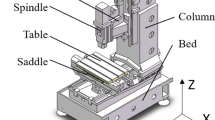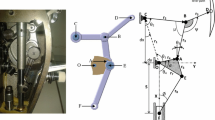Abstract
Based on the matrix method and clearance vector model, a simple, accurate, efficient and general mechanical reliability analysis method is presented to analyze the reliability of a complex linkage mechanism with structural errors and clearances. The output error variances of the latch needle mechanism in double-needle warp knitting machine are obtained based on this matrix method and verified by Monte-Carlo method. Then, an optimization design method for the latch needle mechanism is presented with the use of genetic algorithm, considering the motion requirement and output errors. The optimized latch needle mechanism can meet the double-dwell motion requirement, and has higher displacement accuracy and reliability under the same structural errors and clearance conditions. This method has practical engineering value in solving the contradiction between high precision loop-forming motion and multi-link accumulative errors, reducing cost, and providing a reference for the optimization design for loop forming mechanism in a warp knitting machine.








Similar content being viewed by others
References
Ray SC (2012) Fundamentals and advances in knitting technology. Woodhead Publishing Ltd, Sawston
Liu X, Hu XD, Chen HL (2012) An analysis on the kinematics of looping mechanism of warp knitting machine. Knitt Ind 2:3–5
Shen HP, Li M, Wang MQ et al (2015) Knitting motion analysis and mechanism design for multi-bar warp knitting machine. China Mech Eng 26:1457–1470
Huang XZ, Zhang YM (2010) Robust tolerance design for function generation mechanisms with joint clearances. Mech Mach Theory 45(9):1286–1297
Wittwer JW, Chase KW, Howell LL (2004) The direct linearization method applied to position error in kinematic linkages. Mech Mach Theory 39:681–693
Zhang GJ, Cheng Q, Shao XY et al (2008) Accuracy analysis for planar linkage with multiple clearances at turning pairs. Chin J Mech Eng 21:36–40
Kim J, Song WJ, Kang BS (2010) Stochastic approach to kinematic reliability of open-loop mechanism with dimensional tolerance. Appl Math Model 34:1225–1237
Huang XZ, Zhang YM (2012) Probabilistic approach to system reliability of mechanism with correlated failure models. Math Probl Eng 2012:243–253
Zhang JF, Du XP (2015) Time-dependent reliability analysis for function generation mechanisms with random joint clearances. Mech Mach Theory 92:184–199
Wu JN, Yan SZ, Zuo MJ (2016) Evaluating the reliability of multi-body mechanisms: a method considering the uncertainties of dynamic performance. Reliab Eng Syst Saf 149:96–106
Shi Z (1997) Synthesis of mechanical error in spatial linkages based on reliability concept. Chin J Mech Eng 32(2):255–259
Erkaya S, Uzmay İ (2009) Determining link parameters using genetic algorithm in mechanisms with joint clearance. Mech Mach Theory 44:222–234
Li T, Jia QX, Chen G, Sun HX (2016) Optimization control for space manipulator motion reliability considering multi-index and multi-factor. Int J Hybrid Inf Technol 9(6):273–282
Farajtabar M, Daniali HM, Varedi SM (2016) Error compensation for continuous path operation of 3-RRR planar parallel manipulator with clearance in the joints. J Sci Eng 7:20–33
Gholaminezhad I, Jamali A, Assimi H (2016) Multi-objective reliability-based robust design optimization of robot gripper mechanism with probabilistically uncertain parameters. Nat Comput Appl Forum 2016:1–12
Choi JH, Lee SJ, Choi DH (1998) Stochastic linkage modeling for mechanical error analysis of planar mechanisms. Mech Based Des Struct Mach 26:257–276
Lee SJ, Gilmore BJ (1991) The determination of the probabilistic properties of velocities and accelerations in kinematic chains with uncertainty. J Mech Des 113(1):9–13
Lin PD, Chen JF (1992) Accuracy analysis of planar linkages by the matrix method. Mech Mach Theory 27:507–516
Huang JH, Cao QL (2015) Sinker design of the double needle bar warp knitting machine. Knitt Ind 2:18–21
Acknowledgements
This project is supported by National Natural Science Foundation of China (51375084), Research Fund for the Doctoral Program of Higher Education of China (20130075110002) and the Fundamental Research Funds for the Central Universities (CUSF-DH-D-2017061).
Author information
Authors and Affiliations
Corresponding author
Additional information
Technical Editor: Marcelo A. Trindade.
Rights and permissions
About this article
Cite this article
Su, L., Meng, Z., Sun, Y. et al. Reliability-based optimization design of the latch needle mechanism in double-needle warp knitting machine. J Braz. Soc. Mech. Sci. Eng. 40, 205 (2018). https://doi.org/10.1007/s40430-018-1134-4
Received:
Accepted:
Published:
DOI: https://doi.org/10.1007/s40430-018-1134-4




